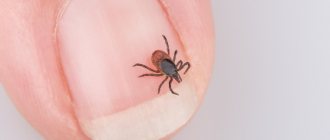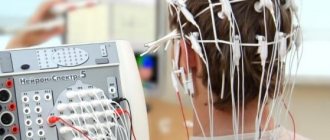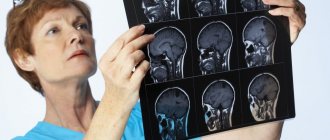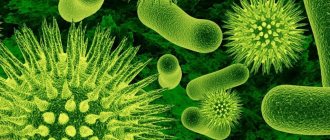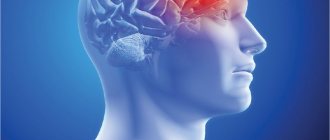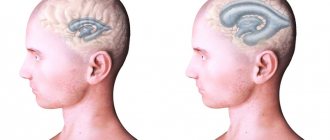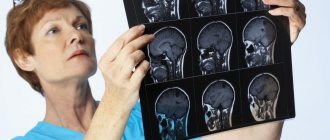Neuroinfections are a group of pathologies of an infectious nature, which are characterized by a severe course, damage to the anatomical structures of the nervous system, and a high mortality rate. Neuroinfection of the brain progresses when pathogenic microorganisms enter the body of an adult or child.
Neuroinfection can develop both primary and secondary. Primary neuroinfections are characterized by the fact that infectious agents initially affect the structures of the nervous system. The development of a secondary neuroinfection is said to occur if infectious agents were transferred by lymphogenous or hematogenous routes from other pathological foci.
Varieties
Neuroinfections in children and adults can occur in acute and chronic forms. The following diseases are classified as acute:
- myelitis;
- tetanus;
- encephalitis;
- rabies;
- meningitis;
- arachnoiditis.
Chronic types of neuroinfection of the brain:
- brucellosis;
- neurosyphilis;
- neurobrucellosis;
- neuroAIDS.
Neuroinfection according to the ICD does not have its own code, but the pathologies that are included in this group have a code. For example, the rabies code according to ICD-10 is A82.
Neuroinfections
The use of systematization is due to the need to combine a large number of heterogeneous infectious pathologies involving the nervous system. Depending on the nature of the morphological changes, clinical features and the specific pathogen in neurology, several groups of CNS lesions of infectious origin are distinguished. The main types of neuroinfections are:
1 .
Encephalitis.
Diseases with inflammation of brain tissue. The most common are tick-borne, herpetic, chickenpox and rubella encephalitis. Manifestations depend on the type of pathogen and may include general cerebral, focal symptoms, systemic intoxication of varying degrees of severity.
2. Meningitis.
Diseases in which there is damage to the meninges. Characterized by the presence of meningeal and intoxication syndromes, taking into account the characteristics of the inflammatory process, they are divided into:
- Purulent
. They are provoked by bacteria, protozoa or fungi, and can be primary or secondary. Primary include meningitis caused by meningococcus, pneumococcus, and Haemophilus influenzae. Secondary lesions are a complication of purulent processes in other localizations - paranasal sinuses, middle ear, etc. - Serous
. Accompanied predominantly by lymphocytic pleocytosis. The causative agents are tuberculosis bacillus, mumps virus, Coxsackie and ECHO enteroviruses.
3. Polio.
Damage to the central nervous system caused by RNA-containing poliovirus. It can occur in two forms: non-paralytic (meningeal, abortive, inapparant) and paralytic (spinal, pontine, bulbar, encephalitic).
4. Brain abscess.
It is an accumulation of purulent masses limited by a capsule in the tissues of the brain. May be of otogenic, rhinogenic, metastatic or post-traumatic origin. It manifests itself as systemic intoxication, focal neurological symptoms, and, less commonly, epileptic and hypertensive syndromes.
5. Shingles
. A variant of chronic neuroinfection caused by human herpesvirus type III – Varicella-Zoster. Persistence of the pathogen in the spinal ganglia is observed with activation during decreased immunity or injury. The main symptoms include acute pain, herpetic rashes in the area of 1-2 dermatomes.
6. Neurosyphilis
. Infectious pathology provoked by Treponema pallidum. At the early stage of damage to the central nervous system, general infectious, general cerebral and focal symptoms are observed with dysfunction of the II, III, VI, VIII pairs of cranial nerves. In the later stages, progressive dementia develops, mental disorders and stroke-like symptoms are identified.
7. Botulism
. An infectious disease caused by Clostridium botulinum and accompanied by interruption of the transmission of nerve impulses at cholinergic synapses. Signs of damage to the motor nuclei of the brain stem and anterior horns are detected.
8. NeuroAIDS.
Caused by infection with the human immunodeficiency virus. Often represented by primary lesions of the central nervous system: encephalopathies, recurrent HIV meningitis, vacuolar myelopathy. Manifestations are varied and include paresis, aphasia, ataxia, mnestic disorders, and psychopathological disorders.
Clinic
Symptoms of neuroinfection are usually very pronounced. It is important to immediately go to see a qualified doctor when the first signs appear, as delay can cost the patient’s life.
Any pathology belonging to the group of nephroinfections is accompanied by three syndromes, which are characterized by certain symptoms:
- liquor hypertension syndrome. It is characterized by intense headache, impaired consciousness, mood changes, tachycardia, tachypnea; intoxicating. An increase in body temperature to critical levels, nausea and vomiting, weakness, decreased ability to work, etc.; liquor syndrome.
Treatment of neuroinfections
Based on the diagnostic studies performed, the clinic’s specialists will choose intensive therapy aimed at:
- Elimination of the causative agent of the disease. For this, the doctor prescribes the most modern antibiotics, antivirals, interferons, and immunoglobulins.
- Eliminating the source of infection. For example, if the source is in the maxillary sinuses, it is necessary to put them in order.
- Restoration of anti-infective immunity. For this purpose, the neurologist will prescribe special medications.
- Stimulating the functions of affected areas of the central nervous system with the help of effective medications.
Therapeutic measures
The consequences of neuroinfection can be extremely unfavorable if it is not detected and treated in a timely manner. Treatment of neuroinfection directly depends on which pathogen is identified during diagnosis. In case of bacterial infection, antibiotics are used. For viral neuroinfection, antiviral therapy is indicated, in particular interferon is prescribed. In addition, symptomatic treatment is carried out - diuretics, nootropics, neuroprotectors, vascular drugs, etc. are prescribed.
If a person has suffered a neuroinfection, then he may experience some changes in behavior, frequent mood changes, decreased mental activity, memory, etc.
Diagnosis of CNS infections in the clinic
Effective treatment of neuroinfections is only possible with an accurate diagnosis. Diagnostic testing may include:
- Examination by a neurologist.
- General urine and blood tests, blood biochemistry.
- Laboratory tests that allow you to identify the pathogen and assess immunity (determination of antibodies to infectious pathogens, PCR diagnostics, cultural cultures). It is a laboratory assessment of immunity that can help determine how the infection entered the central nervous system.
- Electroneuromyography is performed to determine infections of the spinal cord and peripheral nerves.
- Ultrasound diagnostics.
- CT scans of the brain or spinal cord can identify neoplasms and hemorrhages, that is, distinguish infectious causes of central nervous system damage from non-infectious ones.
- Lumbar puncture.
Diagnosis and treatment of neuroinfection. Treatment at the Echinacea Clinic
Treatment will be based on examination data. We will do:
- An examination by a neurologist with examination of reflexes, sensitivity, and coordination will help distinguish neuroinfection from other diseases of the nervous system.
- Search for the pathogen using laboratory tests (antibodies to infections, PCR, culture). Laboratory tests will help find the causative agent of the disease and evaluate the functioning of the immune system. Laboratory assessment of immune status helps to find and close the “loophole” through which the infection entered the nervous system.
- Finding the route of infection. This is necessary to stop the infection from entering the body. For example, we often detect immunological weakening of the mucous membranes with the ensuing consequences (penetration of infections through the mucous membranes, chronic inflammation of the tonsils, sinuses, dysbacteriosis, herpetic infections).
- Diagnosis of immune defense defects. If we are not talking about the bite of a tick, mosquito or sick animal, almost any neuroinfection is a consequence of the weakness of the body’s immune defense.
- Electroneuromyography helps to recognize infectious lesions of the peripheral nerves and spinal cord.
- MR imaging is good at identifying foci of inflammation in the substance of the brain and spinal cord, allowing one to distinguish current inflammation from previous inflammation, from tumor and vascular diseases.
Four main treatment goals:
- Eliminate the pathogen. Here we successfully use antibacterial and antiviral drugs, interferons, and immunoglobulins.
- Block the route of entry of the pathogen. It is necessary to find and neutralize the source of infection (for example, tidy up the paranasal sinuses and palatine tonsils).
- Restore immune defense against infections. We conduct a course of immunorehabilitation based on the results of an immunological examination.
- Stimulate the restoration of the functioning of the affected parts of the nervous system , more details here.
Causes
The etiological factor in the appearance of the disease is the pathogenic effect of pathogens on the human body, which is largely facilitated by:
- hypothermia;
- suffered from acute respiratory viral infections;
- traumatic brain injuries;
- introduction of infection from outside.
As a rule, neuroinfections appear due to existing foci of any purulent infections, lack of control after a severe viral illness, as well as a reduced level of immunity.
Consequences
These infections can sometimes lead to extremely severe results, which are largely related to the part of the brain where the lesion is located.
Almost all those who have recovered from neuroinfectious diseases still have headaches and back pain, aggravated by weather changes, and their memory is weakened. In some cases, the acquisition of epileptic syndrome and hydrocephalus, speech disorder, and disruption of motor functions. Sometimes complete disability occurs, with loss of memory, vision and hearing.
The most serious damage to the nervous system occurs to those who suffered it in the prenatal state. In this case, we can talk about irreparable disorders in the central nervous system and anomalies in the development of internal organs.
The consequences of neuroinfections affect, as a rule, throughout subsequent life. Therefore, immediate medical attention and a timely set of examinations will help prevent deterioration in health after illness.
Pathogenesis
The mechanism of disease development is determined by the form of neuroinfection. Most often, the pathogen enters the central nervous system through the blood, limbus, or perineural spaces. In most cases, the neuron is affected both directly by the infectious agent and by the toxins it secretes.
When affecting the peripheral nervous system, the pathogen initially affects the myelin sheath of the nerve fiber. Long-term severe neuroinfections can subsequently injure the nerve axon.
Diagnostic features
Treatment of neuroinfection of the brain begins with proper diagnosis. First of all, a neurological and somatic examination and an MRI of the brain
. This is necessary to determine the presence of inflammatory edema. Characteristic manifestations of the disease can develop over several days. Patients with neuroinfection require a special individual approach to diagnosing the cardiovascular system. All parameters of segments of the cardiovascular system are examined. If necessary, measures such as capillaroscopy are carried out.
